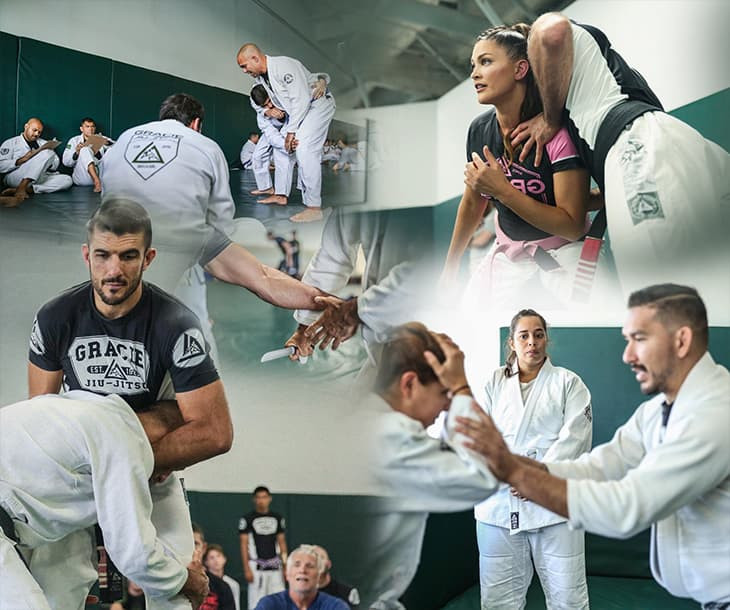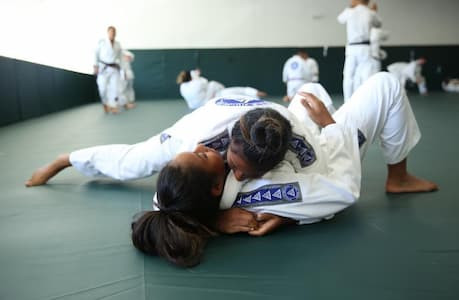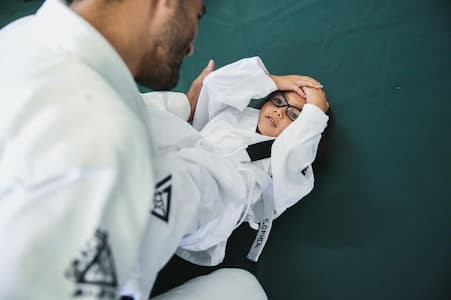History of Self Defense in New York City
Living successfully in New York City has always required a certain amount of street smarts as well as the ability to defend oneself. And that has been case for nearly 400 years, from back when the Dutch founded New Amsterdam to the modern concrete jungle that is NYC today.

Back in the day, fisticuffs, also known as hand-to-hand fighting or bareknuckle brawling, were non-systemized instinctual fight methods popular on the streets of New York. Most of these fights were generally won by the stronger person. It was hard for the physically smaller or weaker person to prevail over somebody tougher than them, unless they could move fast to dodge punches, as a boxer with fancy footwork might do.
Asian martial arts influence is felt in NYC
At the turn of the last century, jiu jitsu – the Japanese martial art that had strong self defense techniques involving using leverage to defeat bigger opponents – first gained popularity in the United States, and in New York City. The word “jiu” means to be gentle or to yield, and the techniques in jiu jitsu involved using what could be a disadvantage (the opponent being bigger) as an advantage to the smaller fighter.
Judo, the Japanese martial similar to jiu jitsu, also came to the U.S. for the first time in this era. This martial art had principles behind it like “softness controls hardness” and “maximum efficiency, minimum effort.”
Theodore Roosevelt was a native New Yorker who built himself up from a weak, asthmatic child, to a strapping man who boxed, wrestled, and boasted of his love of “The Strenuous Life.” He then became interested in judo and worked his way up to getting a brown belt.
When T.R. was president of the United States, he had Yamashita Yoshiaki, a Japanese martial arts instructor, teach him judo and jiu jitsu three times a week right in the White House. “The Art of Jiu Jitsu is worth more in every way than all of our athletics combined,” Roosevelt once said, and his interest in these Asian-based martial arts helped bring these once-unknown techniques to the West. He also demonstrated his self defense moves on his wife, sister-in-law, and even future president William Howard Taft. Roosevelt’s larger-than-life personality and enormous influence helped inform New Yorkers on this new method of self defense.
Self defense techniques learned from the movies
Chinese-American actor and marital arts expert Bruce Lee was an enormous influence when it came to bringing Asian-influenced self defense techniques to New York City. His kung fu-themed movies like Fist of Fury and Enter the Dragon played to packed Times Square movie houses in the 1970s. While “everybody” wasn’t kung fu fighting, some savvy New Yorkers picked up on Lee’s skills to use for self defense.
In the 1990s, Steven Seagal’s blend of martial arts captivated moviegoers, while in this century, Matt Damon’s Jason Bourne movies proved influential. Who wouldn’t want to be able to fight back like these self defense experts did on the silver screen?
Three types of self defense classes in New York City today
These days, New Yorkers who want to learn self defense can do more than emulating presidents and movie stars. There are three different main types of self defense classes available in NYC:
- Cardio fitness classes: You may have seen ads for these sorts of classes that promise that participants will burn off 1200 calories in an hour. These boxing and kickboxing classes are great for working up a sweat and for learning the basics in boxing and kicking. However, the skills taught in the classes are not always translatable to real-life New York City situations. For example, you may not be able to get your way out of a dangerous situation with cardio kickboxing, even if you do work off a lot of calories doing the techniques.
- Traditional self defense classes: Depending on the fitness studio, these classes can encompasses traditional martial arts like Karate, Aikido, Muay Thai, karate, and mixed martial arts. These classes can teach you practical, one-on-one skills to be used in self defense. However, the skills learned here are generally practiced with opponents similar to your size and ability, which will not help you against bigger, stronger opponents.
- Reality-based self defense (RBSD) training classes: Krav Maga, based on Israeli military self defense techniques, contains a blend of mixed martial arts skills and guidance. These sorts of classes teach fierce fighting techniques that both women and men can benefit from. But at the same time, these skills might not be practical in situations where the aggressor is not a stranger.
So what is the best type of class to take in New York City to learn self defense?
The ideal class should teach participants how to always be aware of their surroundings, and given them street smarts. It should show scalable methods of self defense, acknowledging that different situations require different tactics.
In New York, people need to learn skills in self defense both against strangers and against those they know. For example, a woman who is being sexually harassed by her drunken boss is not going to be able to eye gouge the boss or kick him hard. Jiu jitsu skills, like enabling the woman to twist the boss’ wrist to stop him, are more ideal here.
A good self defense class should also give the participants an aura of confidence so they no longer look like potential victims. They can respond in the appropriate way, with skills for everything from verbally stopping abuse to physically responding and being able to fight, even against stronger, bigger opponents. New Yorkers consider themselves both tough and brave, and the best self defense classes empower them to back those skills up with action.
This Certified Gracie Jiu-Jitsu Training Center is independently owned and operated. Gracie Jiu-Jitsu®, Gracie Combatives®, Gracie Bullyproof®, Women Empowered®, and Certified Gracie Jiu-Jitsu Training Center®, are registered trademarks used under license from Gracie University.
Faq
What is self-defense?
Self-defense refers to various modalities of training that typically refer to, but are not limited to, martial arts training - empty hand fighting skill set. As the concept of self-defense training has evolved, a closer look at scenarios involving real world violence (bullying, muggings, robberies, ego fights/assaults, adductions, etc) takes into account things other than the most high percentage fighting tactics and strategies, this includes such things as … verbal and non-verbal assertiveness, reading body language, situational awareness, and boundary setting. The physical martial arts curriculum of a self-defense system should also include tactics and strategies that address being attacked with a weapon and being confronted by multiple opponents
What is the best method of self-defense?
The best method of self-defense is one that addresses the reality of real world violence. From the physical perspective – it is generally understood that most real fights happen in close quarters, in what is typically referred to as the clinch and in often making its way to the ground. Martial arts that specialize in dealing with range that most fights take place and the most common attacks (haymaker punches, headlocks, tackles, grabbing and hitting, WEAPONS etc)
In regards to the non-physical – it should also promote psychological and verbal strategies, along with situational awareness to help someone deal with the realities of a confrontation and most importantly neutralize the threat or avoid it altogether. “The hardest fight is the one you walk away from” “Most fights are avoidable and the result of egos and alcohol” “If something is material and replaceable, give it up, it’s not worth your life”
Self-defense is a term that gets thrown around quite frequently in both martial arts and combat sports. Boxing and Wrestling, for example are very specifically competition sports (amateur, professional, and recreational) This does not mean that these skill sets aren’t useful if confronted in a street assault situation, on the contrary, the attributes developed in these areas of training are highly effective and rather useful, but the overall goals of the sport and context by which the training is presented, are not specifically meant to deal with all the other aforementioned variables of self-defense. Therefore, self-defense in that regard is a by-product, not the main focus of this training.
The pitfalls of systems that solely focus on self-defense training tend to be that they often fall into a martial arts (marketing) niche that tends to fetishize violence to some degree and rather than promote the confidence to walk away and avoid questionable scenarios, it almost feeds the paranoia that might lead one to it. These systems are often recognized by over-dramatic appeals to a fear of being assaulted, unrealistic physical results, claims of connections to a elite military fighting style, and ultimately training that is not testable or live, and ironically don’t resemble the real world skills that are attained through combat sports
What is the best Martial Art for a Street Fight?
In a street fight scenario, it is common to think that you are going to be confronted by someone bigger and stronger, where their intent is to do you great bodily harm and/or knock you out. In this situation, rather than risk being knocked out yourself by standing and trading blows, it is more advisable to neutralize the opponent in the clinch, smother their powerful strikes, and eventually take them to the ground where you can allow them to exhaust their strength advantage, from here the smaller person, has the option of neutralizing the opponent with a choke or joint lock, or even just escape, wait for help, get compliance and withdraw, etc
Out of all the more common martial arts, Gracie Jiu-Jitsu, embodies these strategies and technique. They don’t espouse striking against an opponent, unlike other grappling arts, their context and focus is the assumption that your opponent is bigger and stronger and trying to do you harm, rather than this is a grappling skilled opponent in a tournament setting.
How can self-defense help you?
Self-defense training can often be both empowering and beneficial. Whether it’s a child being bullied, or an adult dealing with the threat of being violently confronted or assaulted, having the ability to defend oneself and their loved ones can give one the confidence as an individual to navigate successfully navigate through such scenarios. This is a quality which usually permeates into other aspects of the their life and may ultimately help them improve as a person by building character, patience, and “piece of mind” that often helps them deal with the daily rigors of their life
How long does it take to learn self defense?
It's depends on the system of self-defense being practiced. If the curriculum is focused on identifying and neutralizing high probability assault scenarios, then it would only be a matter of weeks to learn. One does not need to achieve mastery or a 'black belt' in a martial art to be self-defense ready.
Is self defense necessary?
Self-defense is a necessary part of human development. In one's life time physical, mental and emotional assault will happen and learning to respond with equal force is a necessity. While we live in a more civilized world today, there are always different challenges and pressurs we face. Learning self-defense not only teaches one about enduring physical pressure, but also mental and emotional ones as well.
Can I teach myself self defense?
Yes, it is possible to learn basic self-defense on your own. However, practicing on a non-cooperating partner allows you to sharpen your technique and push yourself to further development.
Do I need to be in good shape or have any experience?
It depends on the martial art. Some disciplines have a higher barrier of entry than others. Jiu Jitsu, is by far the lowest barrier of entry as it was designed for the weaker and smaller individual to develop their strength and confidence.

